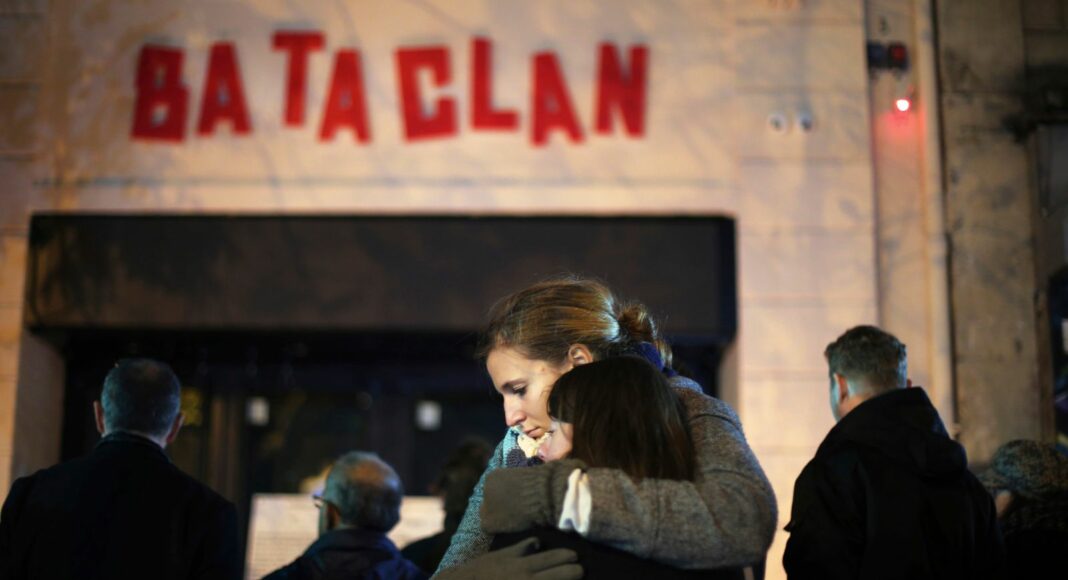On 13 November 2015, 130 people died and hundreds more were injured when jihadist attackers tore through Paris.
Explosions were set off outside the stadium hosting a game with the French national football team, and six bars and restaurants were targeted.
But by far the deadliest facet of the IS-backed plot was the assault on the Bataclan concert hall, where the American band Eagles of Death Metal were playing.
Image:
Some 130 people died and hundreds more were injured. Pic: AP
Some 90 people were killed after the terrorist opened fire on the crowd.
Six years on, a trial is due to get underway at a special tribunal court in Paris.
Proceedings are set to be broadcast to those in court and up to 2,000 people can attend in person.
Arthur Denouveaux, a survivor of the Bataclan music venue attack and president of the Life for Paris victims’ association, said: “Everyone has their own expectations, but we know that this is an important milestone for our future lives.”
It will involve around 330 lawyers, 300 victims and the previous president of France, Francois Hollande.
The case file is more than a million pages, in 542 volumes and measures 53 metres across, according to France24.
A verdict is not expected for at least nine months.
While only one of the suspected attackers – Salah Abdeslam, now 31 – is still alive to go on trial, another 13 people are accused of helping plan or execute the terrorists.
Image:
A new, specially built courtroom, will host the trial into the attacks
Six other people – mostly IS officials – are named on the indictment, although several are thought to be dead.
This is how the attacks panned out:
13 November
France and Germany are playing a game of football at the Stade de France in the north of Paris.
In the 20th minute – around 9.20pm – spectators hear a loud blast, which is also audible to those watching on television.
Two suicide bombers fail to gain entry to the stadium – and so detonate their devices outside, killing themselves and a security guard.
Five minutes later shootings start in the centre of Paris at bars and restaurants – 39 people are killed during the attacks between 9.24pm and 9.36pm.
At 9.41pm, a suicide bomber detonates himself by a restaurant, killing only himself but wounding two others.
Then, at 9.47pm, three gunmen storm into the Bataclan music venue during a gig with automatic weapons.
As they spray bullets at the crowd – numbering more than a thousand – 90 people are hit fatally, with hundreds injured.
Police and the armed forces have started to respond to the attacks, and the theatre ends up under siege.
At 9.53pm, another suicide bomber explodes by the football stadium, killing only himself.
Image:
The first devices were detonated outside the Stade de France stadium – with spectators moving on to the pitch
14 November
Just after midnight, special forces storm the Bataclan.
Two of the terrorists blow themselves up, while a third is shot dead.
In the early hours, Salah Abdeslam – the man who had dropped off the stadium bombers – manages to get back into Belgium.
Just before midday, IS claimed responsibility for the attacks – saying it was a retaliation for France “insulting the prophet” and in retaliation for airstrikes in Iraq and Syria.
Image:
Police raided the Bataclan theatre in the early hours 14 November
18 November
French police and soldiers raid a house in the Paris suburb of Saint-Denis – which turns into a protracted gun battle.
Officers fire more than 5,000 rounds as two suspected terrorists – a man and a woman – die and eight others are arrested.
Abdelhamid Abaaoud, who is thought to have organised the Paris attacks, is one of the dead.
But Abdeslam is not among those detained, and officials continue to investigate.
Image:
Police fired more than 5,000 rounds during a raid in Saint-Denis, in Paris. Pic: AP
November 2015 to March 2016
As the months wear on, raids are carried out in Brussels, and the Belgian towns of Charleroi and Auvelais as the authorities hunt down leads.
The properties investigated are thought to be safe houses, and the remnants of explosives are found, as well as forensic eence linked to Abdeslam.
Most of the properties were rented in cash using pseudonyms.
Image:
Police were looking for Salah Abdeslam
15 March
A joint operation between Belgian and French law enforcement is carried out in the Forest region of Brussels.
One suspect is killed, and four officers injured.
However, two others escape the building and go on the run.
One of those to have escaped is Abdeslam – and his fingerprints were found in the apartment.
Image:
Four officers were injured in the 15 March raid. Pic: AP
18 March
Three days later, counter terrorism police arrest Abdeslam on the streets of Molenbeek in Brussels.
Two accomplices are detained as well, following an extensive intelligence operation in the wake of the Paris attacks five months earlier.
Abdeslam was jailed in 2018 for 20 years for his role in the gunfight on 15 March 2016 that led to his arrest.
During his trial he was uncooperative, and eventually stopped attending – now he will go on trial again.
Image:
Abdeslam was arrested on 18 March 2016. Pic:VTM via AP
22 March
The bloodshed is not over however.
On 22 March 2016, three suicide bombers attack Brussels.
Two devices are set off at the city’s airport, and the third at Maalbeek train station.
Some 32 people are killed by the three attackers, and hundreds more injured.
This attack is also claimed by IS – and Abdeslam was implicated as being part of the plot.
However, the upcoming trial in Paris is only into the attacks in France.
The trial starts on Wednesday 8 September.
It is expected to last until May 2022.




